Submitted:
12 September 2023
Posted:
14 September 2023
You are already at the latest version
Abstract
Keywords:
1. Introduction
1.1. Building carbon footprint assessment
1.2. BIM in assessing the carbon footprint of buildings
2. Materials and Methods
- Stage I. Designing a model for analysis, which is a single-family detached house in timber frame construction, using BIM technology (in Archicad software).
- Stage II. An energy performance simulation of the building was conducted in Archicad, using the EcoDesigner Star add-on. Through examination of the building's geometry, materials, heating and cooling systems, an energy simulation was performed to estimate the energy consumption over the life of the building (50-year period).
- Stage III. A Life Cycle Assessment (LCA) was conducted using the Archicad add-on DesignLCA [41]. A simplified approach was employed, which considered modules A1-A3 responsible for embedded emissions during the product phase, as well as module B during the use phase.
- Stage IV. A second model was analysed, constructed using traditional masonry methods. The previous stages (I-III) were repeated for this secondary model.
- Phase V. A comparative analysis of single-family building models in wood frame and masonry construction was carried out.
2.1. Analysed single-family house model
2.1.1. Building A - Masonry building
2.1.2. Building B - Wooden building
3. Results
3.1. Comparative analysis
3.2. LCA analysis
4. Discussion
5. Conclusions
Author Contributions
Funding
Conflicts of Interest
References
- Mazur, Ł.; Bać, A.; Vaverková, M.D.; Winkler, J.; Nowysz, A.; Koda, E. Evaluation of the Quality of the Housing Environment Using Multi-Criteria Analysis That Includes Energy Efficiency: A Review. Energies 2022, 15, 7750. [Google Scholar] [CrossRef]
- Shen, F.; Simayi, Z.; Yang, S.; Mamitimin, Y.; Zhang, X.; Zhang, Y. A Bibliometric Review of Household Carbon Footprint during 2000–2022. Sustainability 2023, 15, 6138. [Google Scholar] [CrossRef]
- Yan, X.; Cui, S.; Xu, L.; Lin, J.; Ali, G. Carbon Footprints of Urban Residential Buildings: A Household Survey-Based Approach. Sustainability 2018, 10, 1131. [Google Scholar] [CrossRef]
- Isaksson, R.; Rosvall, M.; Espuny, M.; Nunhes, T.V.; De Oliveira, O.J. How Is Building Sustainability Understood?—A Study of Research Papers and Sustainability Reports. Sustainability 2022, 14, 12430. [Google Scholar] [CrossRef]
- Architecture 2030 Why the Building Sector? 2022.
- United Nations Environment Programme 2022 Global Status Report for Buildings and Construction: Towards a Zero-emission, Efficient and Resilient Buildings and Construction Sector. Nairobi.; 2022. 2022.
- Buildings and Climate Change: A Summary for Decision-Makers; UNEP DTIE, Sustainable Consumption and Production Branch: Paris, 2011. ISBN 978-92-807-3064-7.
- Mazur, Ł. Circular Economy in Housing Architecture: Methods of Implementation. ACTA SCIENTIARUM POLONORUM - Architectura Budownictwo 2021, 20, 65–74. [Google Scholar] [CrossRef]
- Atmaca, A.; Atmaca, N. Carbon Footprint Assessment of Residential Buildings, a Review and a Case Study in Turkey. Journal of Cleaner Production 2022, 340, 130691. [Google Scholar] [CrossRef]
- Sizirici, B.; Fseha, Y.; Cho, C.-S.; Yildiz, I.; Byon, Y.-J. A Review of Carbon Footprint Reduction in Construction Industry, from Design to Operation. Materials 2021, 14, 6094. [Google Scholar] [CrossRef]
- Onat, N.C.; Kucukvar, M. Carbon Footprint of Construction Industry: A Global Review and Supply Chain Analysis. Renewable and Sustainable Energy Reviews 2020, 124, 109783. [Google Scholar] [CrossRef]
- Ahmetoğlu, S.; Tanik, A. Management of Carbon Footprint and Determination of GHG Emission Sources in Construction Sector. International Journal of Environment and Geoinformatics 2020, 7, 191–204. [Google Scholar] [CrossRef]
- Starzyk, A.; Donderewicz, M.; Rybak-Niedziółka, K.; Marchwiński, J.; Grochulska-Salak, M.; Łacek, P.; Mazur, Ł.; Voronkova, I.; Vietrova, P. The Evolution of Multi-Family Housing Development Standards in the Climate Crisis: A Comparative Analysis of Selected Issues. Buildings 2023, 13, 1985. [Google Scholar] [CrossRef]
- ISO 14040:2006 - Environmental Management -- Life Cycle Assessment -- Principles and Framewor. In.
- ISO 14044:2006 - Environmental Management — Life Cycle Assessment — Requirements and Guidelines. In.
- Pacheco-Torres, R.; Jadraque, E.; Roldán-Fontana, J.; Ordóñez, J. Analysis of CO2 Emissions in the Construction Phase of Single-Family Detached Houses. Sustainable Cities and Society 2014, 12, 63–68. [Google Scholar] [CrossRef]
- Vilches, A.; Garcia-Martinez, A.; Sanchez-Montañes, B. Life Cycle Assessment (LCA) of Building Refurbishment: A Literature Review. Energy and Buildings 2017, 135, 286–301. [Google Scholar] [CrossRef]
- Banias, G.F.; Karkanias, C.; Batsioula, M.; Melas, L.D.; Malamakis, A.E.; Geroliolios, D.; Skoutida, S.; Spiliotis, X. Environmental Assessment of Alternative Strategies for the Management of Construction and Demolition Waste: A Life Cycle Approach. Sustainability 2022, 14, 9674. [Google Scholar] [CrossRef]
- Rodríguez, L.; Martínez, L.; Panameño, R.; París, O.; Muros, A.; Rodríguez, R.; Javier, R.; González, C. LCA of the NZEB El Salvador Building, a Model to Estimate the Carbon Footprint in a Tropical Country. Journal of Cleaner Production 2023, 408, 137137. [Google Scholar] [CrossRef]
- Säynäjoki, A.; Heinonen, J.; Junnila, S. Carbon Footprint Assessment of a Residential Development Project. IJESD 2011, 116–123. [Google Scholar] [CrossRef]
- Tulevech, S.M.; Hage, D.J.; Jorgensen, S.K.; Guensler, C.L.; Himmler, R.; Gheewala, S.H. Life Cycle Assessment: A Multi-Scenario Case Study of a Low-Energy Industrial Building in Thailand. Energy and Buildings 2018, 168, 191–200. [Google Scholar] [CrossRef]
- Ciroth, A. ICT for Environment in Life Cycle Applications openLCA — A New Open Source Software for Life Cycle Assessment. Int J Life Cycle Assess 2007, 12, 209–210. [Google Scholar] [CrossRef]
- How Important Is the LCA Software Tool You Choose? Comparative Results from GaBi, openLCA, SimaPro and Umberto.
- Hemmati, M.; Messadi, T.; Gu, H. Life Cycle Assessment of Cross-Laminated Timber Transportation from Three Origin Points. Sustainability 2021, 14, 336. [Google Scholar] [CrossRef]
- Luz, L.M.D.; Francisco, A.C.D.; Piekarski, C.M.; Salvador, R. Integrating Life Cycle Assessment in the Product Development Process: A Methodological Approach. Journal of Cleaner Production 2018, 193, 28–42. [Google Scholar] [CrossRef]
- Olagunju, B.D.; Olanrewaju, O.A. COMPARISON OF LIFE CYCLE ASSESSMENT TOOLS IN CEMENT PRODUCTION. SAJIE 2020, 31. [Google Scholar] [CrossRef]
- Grossi, F.; Ge, H.; Zmeureanu, R.; Baba, F. Feasibility of Planting Trees around Buildings as a Nature-Based Solution of Carbon Sequestration—An LCA Approach Using Two Case Studies. Buildings 2022, 13, 41. [Google Scholar] [CrossRef]
- Antón, L.Á.; Díaz, J. Integration of Life Cycle Assessment in a BIM Environment. Procedia Engineering 2014, 85, 26–32. [Google Scholar] [CrossRef]
- Doan, D.T.; Ghaffarianhoseini, A.; Naismith, N.; Ghaffarianhoseini, A.; Zhang, T.; Tookey, J. Examining Green Star Certification Uptake and Its Relationship with Building Information Modelling (BIM) Adoption in New Zealand. Journal of Environmental Management 2019, 250, 109508. [Google Scholar] [CrossRef]
- Potrč Obrecht, T.; Röck, M.; Hoxha, E.; Passer, A. BIM and LCA Integration: A Systematic Literature Review. Sustainability 2020, 12, 5534. [Google Scholar] [CrossRef]
- Soust-Verdaguer, B.; Llatas, C.; García-Martínez, A. Critical Review of Bim-Based LCA Method to Buildings. Energy and Buildings 2017, 136, 110–120. [Google Scholar] [CrossRef]
- Röck, M.; Hollberg, A.; Habert, G.; Passer, A. LCA and BIM: Visualization of Environmental Potentials in Building Construction at Early Design Stages. Building and Environment 2018, 140, 153–161. [Google Scholar] [CrossRef]
- Carvalho, J.P.; Alecrim, I.; Bragança, L.; Mateus, R. Integrating BIM-Based LCA and Building Sustainability Assessment. Sustainability 2020, 12, 7468. [Google Scholar] [CrossRef]
- Bueno, C.; Fabricio, M.M. Comparative Analysis between a Complete LCA Study and Results from a BIM-LCA Plug-In. Automation in Construction 2018, 90, 188–200. [Google Scholar] [CrossRef]
- Antón, L.Á.; Díaz, J. Integration Of Lca And Bim For Sustainable Construction. 2014. [CrossRef]
- Santos, R.; Costa, A.A.; Silvestre, J.D.; Pyl, L. Integration of LCA and LCC Analysis within a BIM-Based Environment. Automation in Construction 2019, 103, 127–149. [Google Scholar] [CrossRef]
- Kim, J.B.; Jeong, W.; Clayton, M.J.; Haberl, J.S.; Yan, W. Developing a Physical BIM Library for Building Thermal Energy Simulation. Automation in Construction 2015, 50, 16–28. [Google Scholar] [CrossRef]
- Kamel, E.; Memari, A.M. Review of BIM’s Application in Energy Simulation: Tools, Issues, and Solutions. Automation in Construction 2019, 97, 164–180. [Google Scholar] [CrossRef]
- Wei, H.; Zheng, S.; Zhao, L.; Huang, R. BIM-Based Method Calculation of Auxiliary Materials Required in Housing Construction. Automation in Construction 2017, 78, 62–82. [Google Scholar] [CrossRef]
- Kim, K.P. BIM-Enabled Sustainable Housing Refurbishment—LCA Case Study. In Sustainable Construction Technologies; Elsevier, 2019; pp. 349–394. ISBN 978-0-12-811749-1.
- Lendager Architects; Formfaktor Aps DesignLCA. Available online: https://www.designlca.com/.
- EN 15804+A2 - Sustainability of Construction Works - Environmental Product Declarations - Core Rules for the Product Category of Construction Products.
- Winkler, J.; Jeznach, J.; Koda, E.; Sas, W.; Mazur, Ł.; Vaverková, M. Promoting Biodiversity: Vegetation in a Model Small Park Located in the Research and Educational Centre. J. Ecol. Eng. 2022, 23, 146–157. [Google Scholar] [CrossRef]
- Winkler, J.; Mazur, Ł.; Smékalová, M.; Podlasek, A.; Hurajová, E.; Koda, E.; Jiroušek, M.; Jakimiuk, A.; Vaverková, M.D. Influence of Land Use on Plant Community Composition in Vysocina Region Grasslands, Czech Republic. Environ. Protect. Eng. 2022, 48. [Google Scholar] [CrossRef]
- Vijayan, D.S.; Devarajan, P.; Sivasuriyan, A.; Stefańska, A.; Koda, E.; Jakimiuk, A.; Vaverková, M.D.; Winkler, J.; Duarte, C.C.; Corticos, N.D. A State of Review on Instigating Resources and Technological Sustainable Approaches in Green Construction. Sustainability 2023, 15, 6751. [Google Scholar] [CrossRef]
- Magwood, C.; Bowden, E.; Javaria Ahmad; Deluca, M.; Treadaway, E.; Douglas, N. Establishing the Average Upfront Material Carbon Emissions in New Low-Rise Residential Home Construction in the City of Nelson & the City of Castlegar. 2022. [CrossRef]
- Magwood, C.; Huynh, T. The Hidden Climate Impact of Residential Construction; RMI, 2023.
- Arceo, A.; Tham, M.; Guven, G.; MacLean, H.L.; Saxe, S. Capturing Variability in Material Intensity of Single-Family Dwellings: A Case Study of Toronto, Canada. Resources, Conservation and Recycling 2021, 175, 105885. [Google Scholar] [CrossRef]
- Marchwiński, J.; Starzyk, A.; Kopyłow, O.; Kurtz-Orecka, K. Impact of Atrium Glazing with and without BIPV on Energy Performance of the Low-Rise Building: A Central European Case Study. Energies 2023, 16, 4683. [Google Scholar] [CrossRef]
- Bierwirth, A.; Thomas, S. Estimating the Sufficiency Potential in Buildings: The Space between under Dimensioned and Oversized. ECEEE SUMMER STUDY PROCEEDINGS 2019. [Google Scholar]
- Seo, S.; Hwang, Y. Estimation of CO2 Emissions in Life Cycle of Residential Buildings. J. Constr. Eng. Manage. 2001, 127, 414–418. [Google Scholar] [CrossRef]
- Moncaster, A.M.; Symons, K.E. A Method and Tool for ‘Cradle to Grave’ Embodied Carbon and Energy Impacts of UK Buildings in Compliance with the New TC350 Standards. Energy and Buildings 2013, 66, 514–523. [Google Scholar] [CrossRef]
- Rybak-Niedziółka, K.; Starzyk, A.; Łacek, P.; Mazur, Ł.; Myszka, I.; Stefańska, A.; Kurcjusz, M.; Nowysz, A.; Langie, K. Use of Waste Building Materials in Architecture and Urban Planning—A Review of Selected Examples. Sustainability 2023, 15, 5047. [Google Scholar] [CrossRef]
- Sathre, R.; O’Connor, J. Meta-Analysis of Greenhouse Gas Displacement Factors of Wood Product Substitution. Environmental Science & Policy 2010, 13, 104–114. [Google Scholar] [CrossRef]
- Polgár, A. Carbon Footprint and Sustainability Assessment of Wood Utilisation in Hungary. Environ Dev Sustain 2023. [Google Scholar] [CrossRef]
- Gustavsson, L.; Pingoud, K.; Sathre, R. Carbon Dioxide Balance of Wood Substitution: Comparing Concrete- and Wood-Framed Buildings. Mitig Adapt Strat Glob Change 2006, 11, 667–691. [Google Scholar] [CrossRef]
- Werner, F.; Richter, K. Wooden Building Products in Comparative LCA: A Literature Review. Int J Life Cycle Assess 2007, 12, 470–479. [Google Scholar] [CrossRef]
- Shao, L.; Chen, G.Q.; Chen, Z.M.; Guo, S.; Han, M.Y.; Zhang, B.; Hayat, T.; Alsaedi, A.; Ahmad, B. Systems Accounting for Energy Consumption and Carbon Emission by Building. Communications in Nonlinear Science and Numerical Simulation 2014, 19, 1859–1873. [Google Scholar] [CrossRef]
- Kasperski, J.; Bać, A.; Oladipo, O. A Simulation of a Sustainable Plus-Energy House in Poland Equipped with a Photovoltaic Powered Seasonal Thermal Storage System. Sustainability 2023, 15, 3810. [Google Scholar] [CrossRef]
- Ramesh, T.; Prakash, R.; Shukla, K.K. Life Cycle Energy Analysis of Buildings: An Overview. Energy and Buildings 2010, 42, 1592–1600. [Google Scholar] [CrossRef]
- Min, J.; Yan, G.; Abed, A.M.; Elattar, S.; Amine Khadimallah, M.; Jan, A.; Elhosiny Ali, H. The Effect of Carbon Dioxide Emissions on the Building Energy Efficiency. Fuel 2022, 326, 124842. [Google Scholar] [CrossRef]
- Feist, W. Active for More Comfort: Passive House; International Passive House Association: Darmstadt, 2018. [Google Scholar]
- Peper, S.; Feist, W. Energy Efficiency of the Passive House Standard: Expectations Confirmed by Measurements in Practice; Passive House Institute: Darmstadt, 2015. [Google Scholar]
- Godlewski, T.; Mazur, Ł.; Szlachetka, O.; Witowski, M.; Łukasik, S.; Koda, E. Design of Passive Building Foundations in the Polish Climatic Conditions. Energies 2021, 14, 7855. [Google Scholar] [CrossRef]
- James, M.; Bill, J. Passive House in Different Climates: The Path to Net Zero; Routledge, Taylor & Francis Group: New York, 2016; ISBN 978-1-138-90403-3. [Google Scholar]
- Wąs, K.; Radoń, J.; Sadłowska-Sałęga, A. Maintenance of Passive House Standard in the Light of Long-Term Study on Energy Use in a Prefabricated Lightweight Passive House in Central Europe. Energies 2020, 13, 2801. [Google Scholar] [CrossRef]

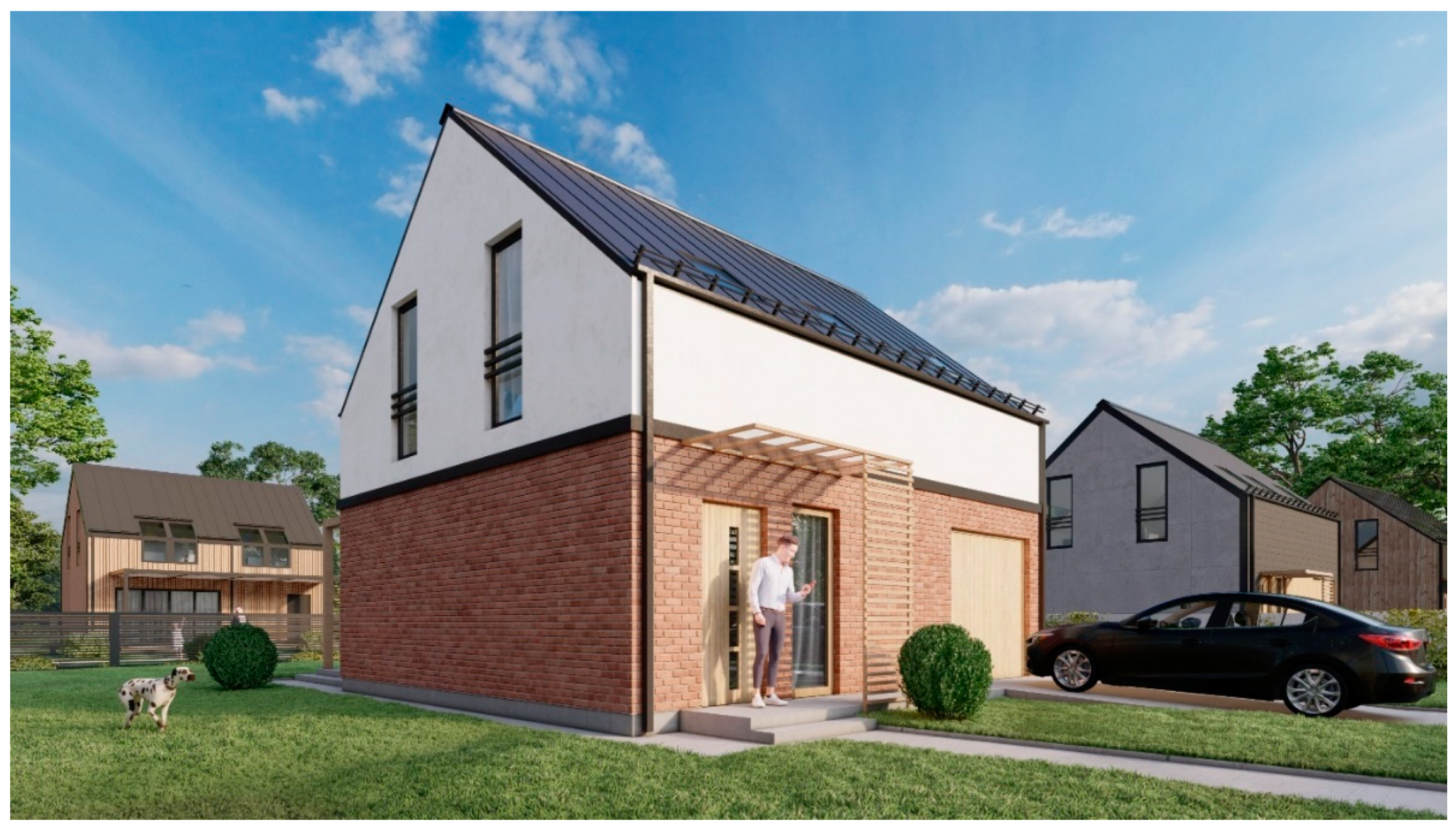
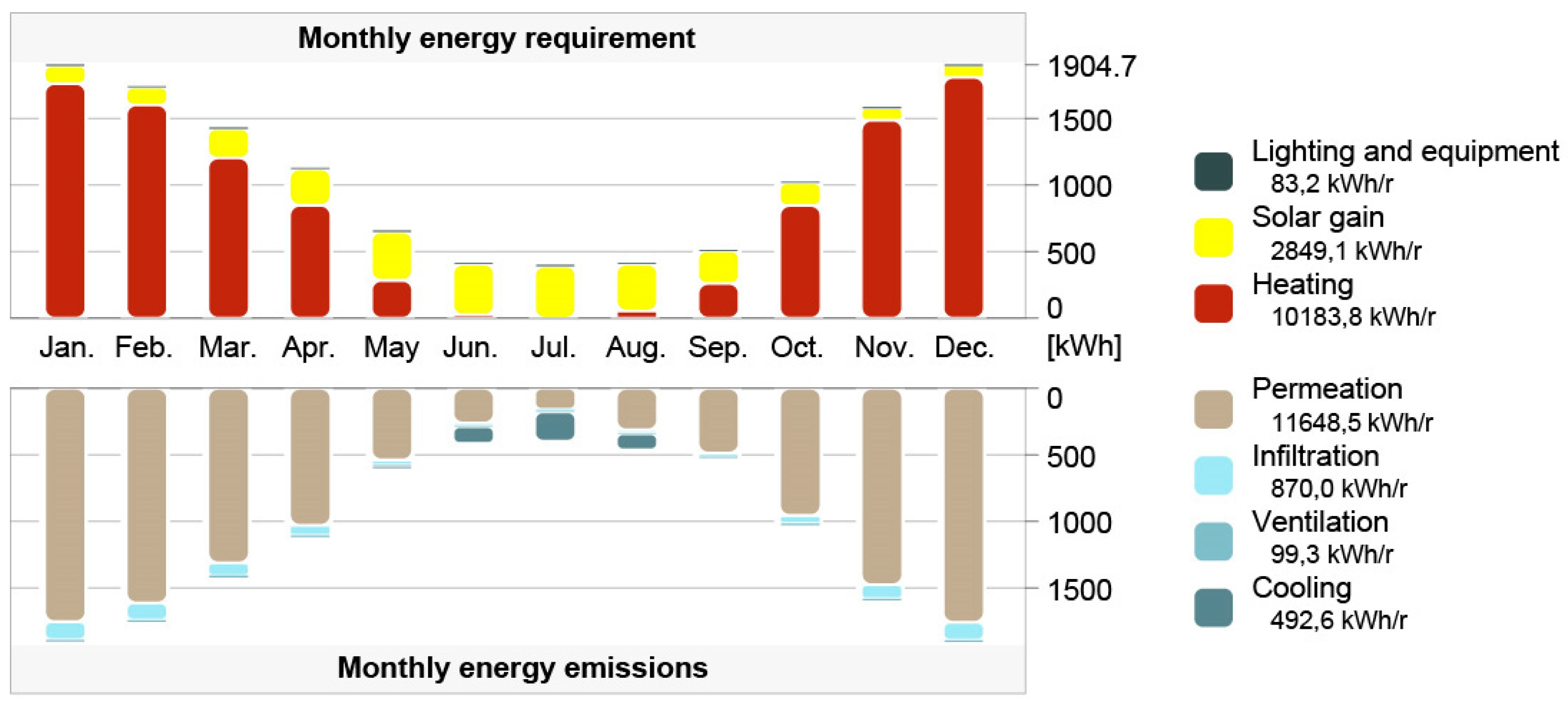
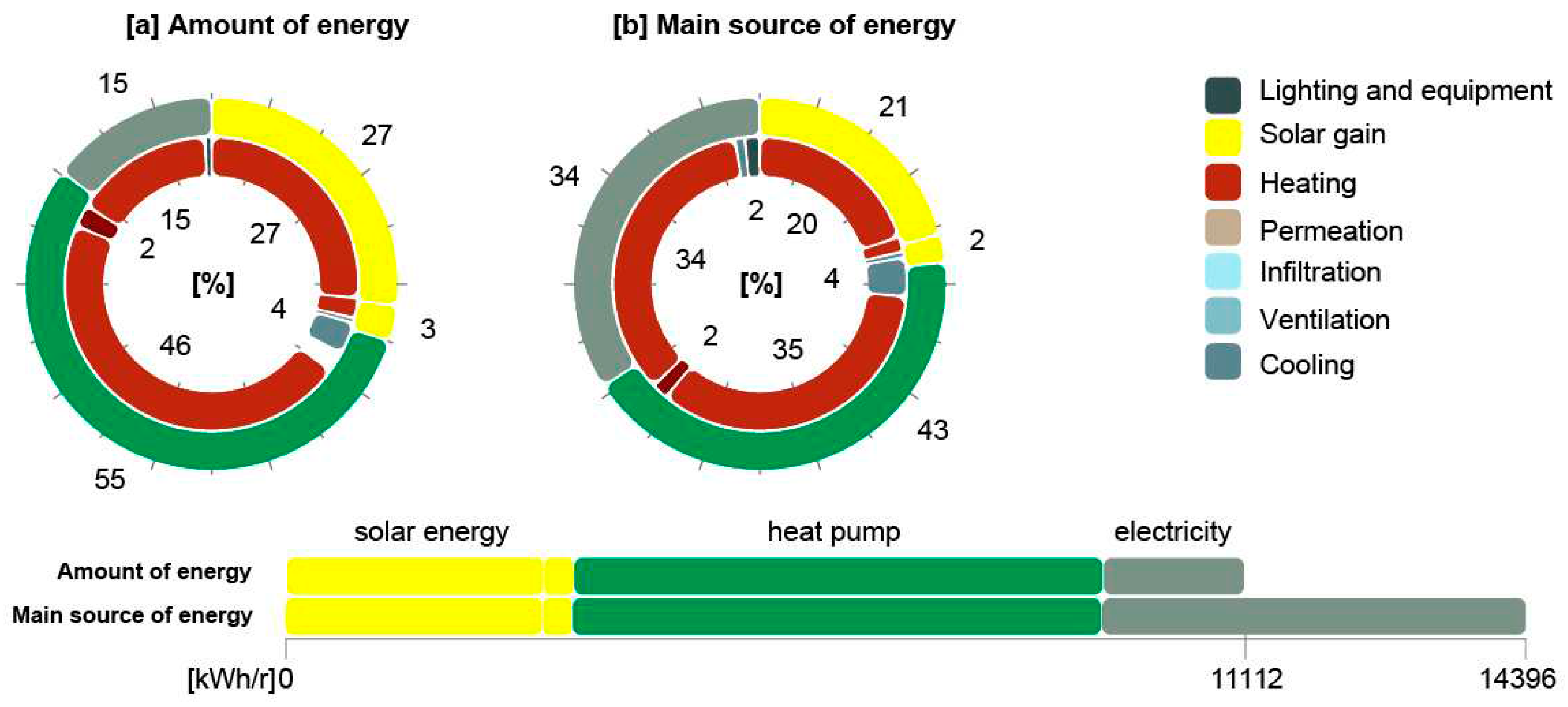
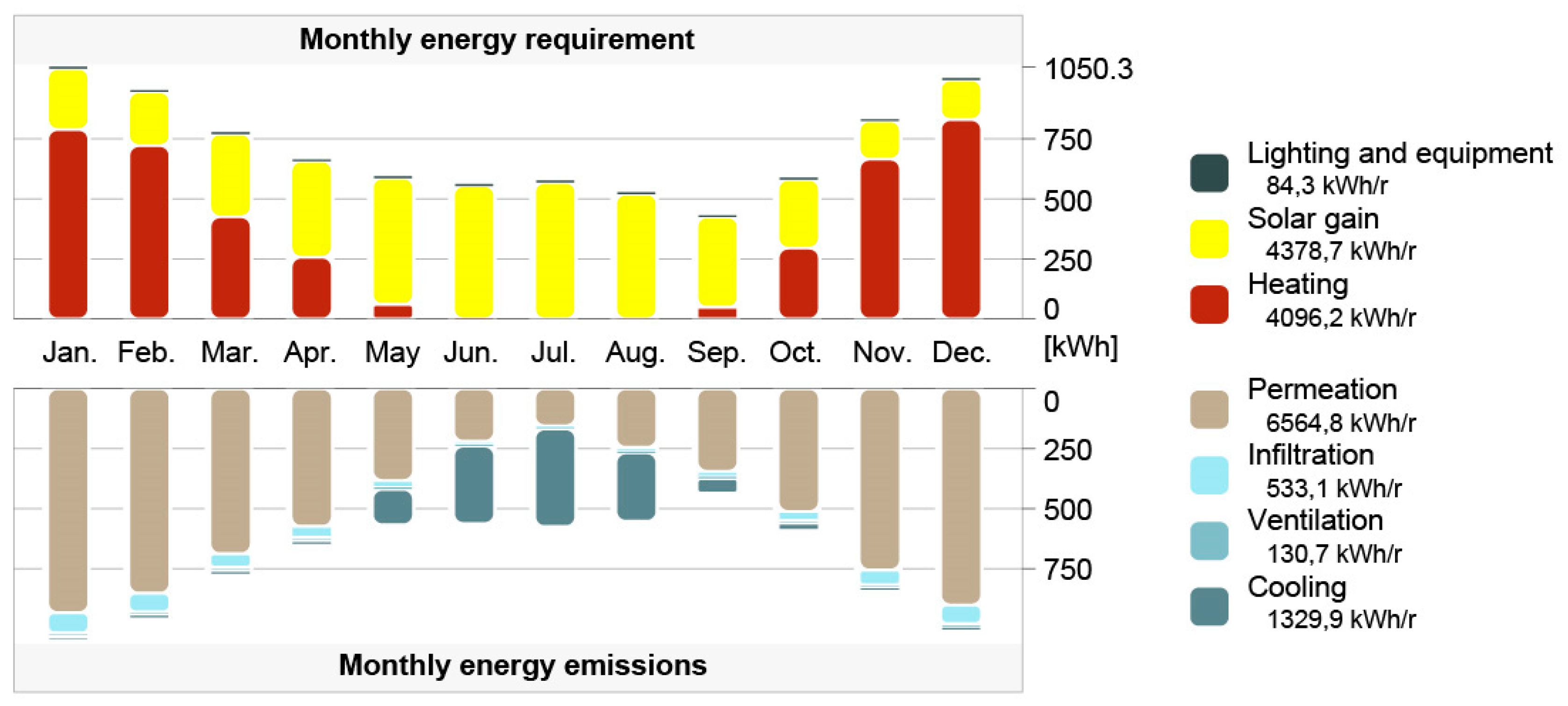
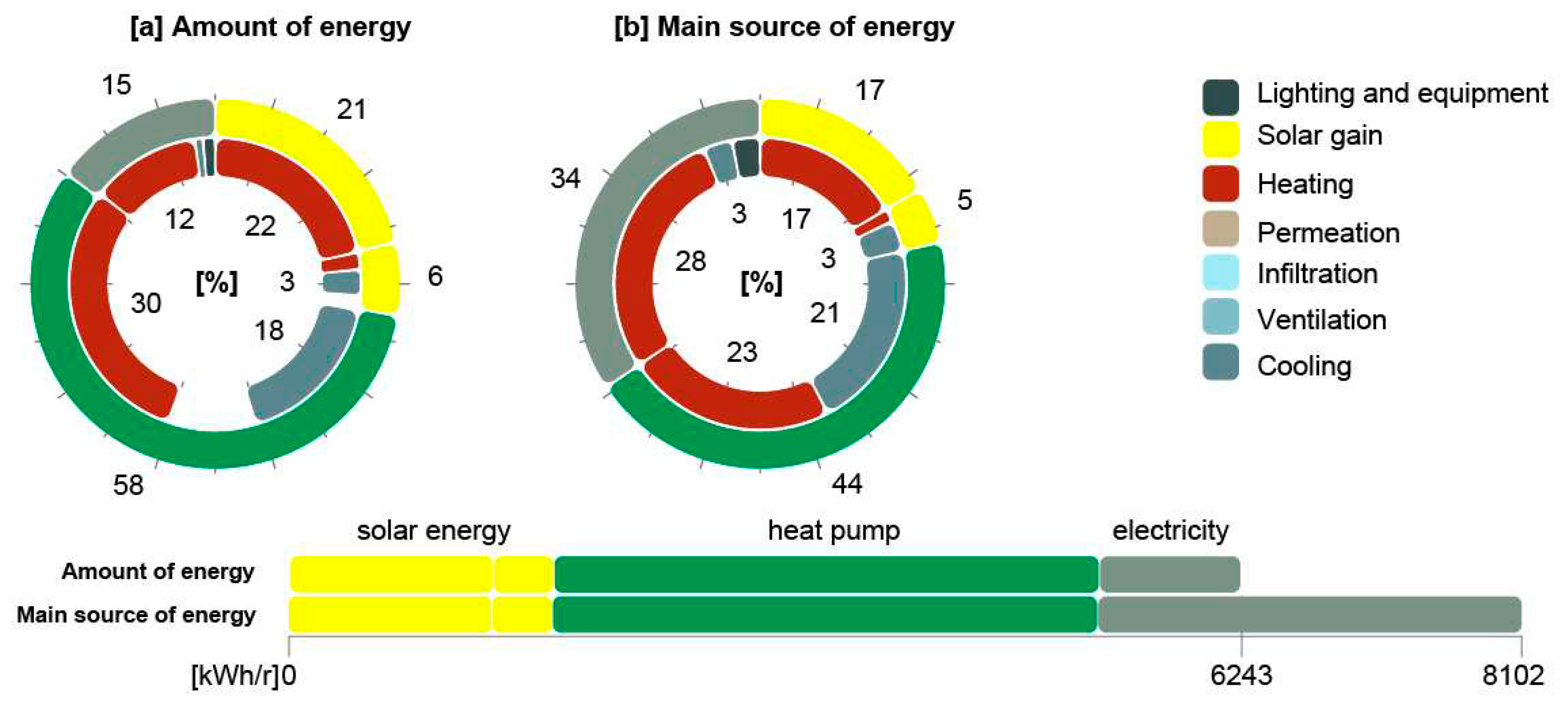
| Software | Description |
|---|---|
| OpenLCA | OpenLCA is an advanced open source software for Life Cycle Assessment (LCA) and Environmental Impact Assessment (EIA) of products and services. It has the advantage of being accessible and versatile, which makes it widely used in research and industrial practise [22]. |
| SimaPro + Report Maker | SimaPro is a professional tool that provides a comprehensive assessment of the environmental footprint of products and processes. Report Maker is a tool that integrates with SimaPro and allows the creation of advanced reports and visualisations of the results of the LCA [23]. |
| Tally (GaBi) | Tally is a specialised software dedicated to analysis in the construction sector, mainly in the United States [24]. |
| Umberto LCA+ | Umberto LCA+ can calculate carbon footprints, perform LCA analysis, create EPD declarations, and use the integrated ecoinvent database [25,26]. |
| One Click LCA Product Carbon & EPD Generator | One-Click LCA is an expert package that allows you to split into an LCA module and a Carbon Footprint + EPD. However, the functionality of this software is limited to calculating the carbon footprint. It is integrated with an EPD generator based on the EN15804 standard [27]. |
| Software | Description |
|---|---|
| One Click LCA | It is a commonly used assessment tool to measure the environmental sustainability of construction projects. One Click LCA can be added to Autodesk Revit, ArchiCAD and SketchUp as an additional feature. It enables users to perform sustainability assessments during the design process, considering factors like building materials, energy usage, and emissions. |
| Tally | It is an add-on to Autodesk Revit that allows you to explore the environmental impact of buildings as you design them. It allows the assessment of various aspects of sustainability, including carbon footprint, energy consumption, water consumption, materials, and waste. |
| eToolLCD | It is a cloud-based LCA tool that integrates with BIM software such as Revit and ArchiCAD. It allows detailed LCA analyses to be carried out, taking into account various aspects of the building, such as building materials, energy consumption, waste management, and greenhouse gas emissions. |
| EC3 (Embodied Carbon in Construction Calculator) | It is an LCA tool developed by the Carbon Leadership Forum. It can be an add-on to BIM software such as Revit, Rhino, and Grasshopper. It makes it easy to measure the carbon footprint of building materials, which can help designers choose sustainable materials and make informed decisions about construction. |
| Parameter | Building A Masonry building |
Building B Wooden building |
unit |
|---|---|---|---|
| Gross floor area | 153,80 | 139,80 | m2 |
| Usable floor area | 113,90 | 115,70 | m2 |
| Number of storeys | 2 | 2 | |
| Number of bedrooms | 3 | 3 | units |
| U-value thermal conductivity coefficient [W/m²K] | |||
| external walls | 0,16 | 0,17 | W/m²K |
| roof | 0,12 | 0,12 | W/m²K |
| floor on the ground | 0,14 | 0,14 | W/m²K |
| Net heating energy | 57,21 | 41,32 | kWh/m²r |
| Net cooling energy | 5,02 | 12,13 | kWh/m²r |
| Total net energy | 62,23 | 53,45 | kWh/m²r |
| Energy consumption | 63,02 | 54,19 | kWh/m²r |
| Fuel consumption | 9,34 | 9,11 | kWh/m²r |
| CO2 emissions | 2,02 | 1,97 | kg/m²r |
| Internal temperature (annual average value) |
|||
| heated rooms | 20,66 | 21,51 | °C |
| non-heated rooms | 14,83 | 15,32 | °C |
| Material | Unit | Density (kg/m3) | Embodied energy (MJ/kg) PENRT A1-3 | Carbon data (kg CO2/unit) | Water m^3/m^3 |
|---|---|---|---|---|---|
| Reinforcing Steel | kg | 7850 | 5545 | 0,47 | 1,4540 |
| Concrete C20/25 | kg/m³ | 2400 | 912 | 178,00 | 0,7600 |
| Masonry bricks | kg/m³ | 575 | 1180 | 113,00 | 0,1710 |
| KVH cnstruction timber | kg/m³ | 492,92 | 1124 | -767,80 | 0,2247 |
| External silicone plaster | kg | 1700 | 13,79 | 0,69 | 0,0219 |
| Internal gypsum plaster | kg/m³ | 1000 | 87,27 | 119,40 | 0,2412 |
| Steel galvanized | kg | 7850 | 25,86 | 2,78 | 0,0031 |
| Gypsum Fibreboard | kg/m³ | 1180 | 17,4 | 1,14 | 0,0070 |
| Gypsum plaster board | kg/m² | 10 | 34,85 | 1,62 | 0,0079 |
| Swisskrono OSB | kg/m³ | 614,5 | 3950 | -890,00 | 0,7980 |
| Solid wood parquet | kg/m² | 575 | 87,27 | -18,74 | 0,0230 |
| Aerated concrete P3 | kg/m³ | 380 | 1263 | 184,40 | 0,6385 |
| Sand | kg | 1 | 0,03812 | 0,00 | 0,0000 |
| Profiled aluminium sheets for roof | kg/m² | 2,9 | 360,3 | 27,03 | 0,3715 |
| Stoneware tiles glazed | kg/m² | 20 | 100,4 | 6,18 | 0,0135 |
| Stone wool aqustic insulation | kg/m³ | 155 | 1836 | 196,60 | 0,4590 |
| Stone wool heat insulation | kg/m³ | 155.0 | 1836 | 196,60 | 0,4590 |
| Extruded Polystyrene (XPS) foam board | kg/m³ | 32.7 | 786,5 | 54,24 | 0,3555 |
| Air barrier membrane | kg/m² | 0,1715 | 15,81 | 1,18 | 0,0149 |
| PE foil dimpled | kg/m² | 1,2 | 114,7 | 4,12 | 0,0161 |
| Humidity variable air and vapour membrane | kg/m² | 0,092 | 12,53 | 0,53 | 0,0035 |
| Underroof membrane reinforced PE fabric | kg/m² | 0.14 | 10,96 | 0,43 | 0,0037 |
| Construction component |
Building A Masonry building |
Building B Wooden building |
||
|---|---|---|---|---|
| [kg CO2e] | [%] | [kg CO2e] | [%] | |
| Foundations | 1045,61 | 3,69% | 1030,86 | -103,19% |
| External walls | 9829,70 | 34,70% | 159,75 | -15,99% |
| Internal walls | 1307,40 | 4,62% | -754,03 | 75,48% |
| Inter-storey floor | 4076,31 | 14,39% | -5191,64 | 519,67% |
| Roof | 1271,73 | 4,49% | 1376,55 | -137,79% |
| Internal installations | 2575,00 | 9,09% | 224,00 | -22,42% |
| Stairs | 2035,05 | 7,18% | -573,21 | 57,38% |
| Windows | 5971,84 | 21,08% | 2515,39 | -251,78% |
| Doors | 213,30 | 0,75% | 213,30 | -21,35% |
| Global Warming Potential - total (GWP-total) | 28325,94 | 100,00% | -999,03 | 100,00% |
| Total emission | 28325,94 | 5519,85 | ||
| Excess CO2 accumulation | 0,00 | -6518,88 | ||
| Life cycle phase | Cumulative energy [MJ] | |
|---|---|---|
| Building A Masonry building |
Building B Wooden building |
|
| A1-A3 production stage | 9 340 581,87 | 7 936 714,68 |
| Life cycle phase | Carbon footprint [kg CO2 e] | |
|---|---|---|
| Building A Masonry building |
Building B Wooden building |
|
| A1-A3 production stage | 28 325,94 | -2 019,89 |
| B6 energy consumption over a 50-year life cycle | 17 734,35 | 10 326,62 |
| Total | 46 060,29 | 8 306,73 |
| Life cycle phase | Water consumption [m3] | |
|---|---|---|
| Building A Masonry building |
Building B Wooden building |
|
| A1-A3 production stage | 2 536,46 | 2 121,80 |
| House type | Net Emissions kg CO2e |
Emissions Intensity kg CO2e/m2 |
Emissions Intensity kg CO2e/m2/yr |
Emissions Intensity kg CO2e/bedroom |
Energy kWh/yr |
|---|---|---|---|---|---|
| Building A – Masonry building | 46 060,29 | 299,48 | 5,99 | 15 353,43 | 94,87 |
| Building B – Wooden building | 8 306,73 | 59,42 | 1,19 | 2 768,91 | 47,72 |
Disclaimer/Publisher’s Note: The statements, opinions and data contained in all publications are solely those of the individual author(s) and contributor(s) and not of MDPI and/or the editor(s). MDPI and/or the editor(s) disclaim responsibility for any injury to people or property resulting from any ideas, methods, instructions or products referred to in the content. |
© 2023 by the authors. Licensee MDPI, Basel, Switzerland. This article is an open access article distributed under the terms and conditions of the Creative Commons Attribution (CC BY) license (http://creativecommons.org/licenses/by/4.0/).





